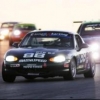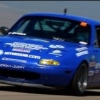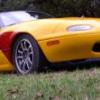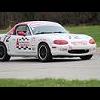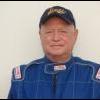
New Miata Never raced, but SAI is Wayyy off
#41

 Posted 09-13-2011 05:39 PM
Posted 09-13-2011 05:39 PM

corner weights
663 631
609 554
CW: 50.4% or 1240 lbs(intentionally higher than 50% for most important right hand turns leading to 1/4 mile straight)Total weight 2457 lbs (right front ride height is also 1/8" higher for the same reason.)
4 7/8" 5"
4 7/8" 4 7/8
Alignment settings:
Front
camber -2.8 -2.8
caster 4.7 4.7
toe 0 0
Rear
camber -2.7 -2.7
toe .07 .08
These numbers were all before the cam was modified. i have no new weights or data post-mods.
What else do you need, Dave? My emphasis on right hand turns is due to the need to go through those last 2 turns leading onto the longest straight-away on our track; and there are more right hand turns than left. Thank you very much.
#42

 Posted 09-13-2011 05:43 PM
Posted 09-13-2011 05:43 PM

#43

 Posted 09-13-2011 06:13 PM
Posted 09-13-2011 06:13 PM




#44

 Posted 09-13-2011 06:45 PM
Posted 09-13-2011 06:45 PM

Rear is toe in.While I'm just starting to experiment with my suspension setup, the lack of rake, nearly the same camber front to rear, and almost no wedge makes me think it will be prone to understeer both directions. Is that toe out or toe in for the rear numbers?
#45

 Posted 09-13-2011 07:07 PM
Posted 09-13-2011 07:07 PM

A Miata has no power so to get speed, you need to be full on the gas as much as possible without going off the track. WOT will lighten your front end reducing grip. Also, if you're not sliding, you're just cruising but if you slide but don't rotate the car, your arc will straighten out and you'll find yourself running out of asphault.
You want the car to grip more on the front and slide more on the rear to keep maximum throttle and still let the car turn through a corner. This is why the front bar is typically set soft (more grip) and the rear middle or stiff (less grip) You can alter the balance with the throttle but lift and you lose precious speed.
Lowering the front will increase your camber numbers (more grip) and change the weight displacement to provide more grip as well. It also provides better aerodynamics in a straight line.
Your front camber nearly identical to your rear. The JD baseline setup has 1* more up front than the rear to make the front stickier.
Your front toe is good for straight line speed but if you add a hair of toe out, it will turn in better. Your rear toe in will make the wheels want to go straight...good if you have a lot of power that you need to control on turn exit but we don't have that so the prescription is usually a bit of toe out in the front and none in the rear, or something close to that.
Finally .4% wedge won't change things much for you. People I talk to who are setting their suspension up for a specific track will wedge or dewedge by a couple percent.
I am just learning this stuff so if the people who really do know their stuff think I'm way off, please correct me. With a couple of the changes I've made, I have found an amazing difference in how the car behaves.



#46

 Posted 09-13-2011 07:21 PM
Posted 09-13-2011 07:21 PM

"I didn't know, what I didn't know"
If you're going to learn it, get Daves book.
Download JD's setup guide and go from there.
If you need/want track time and want to have fun.
Find a local SM shop, have them fully check it out and get out there and have some fun.
From there, there's always the shop or you doing what you can and what you've learned.
Some want to race and little wrench.
Some like to wrench and little race.
Some in between and only you know.
Ask away but get the car to a point you know everything is okay and then go from there.
Not, "the sky if falling" I think ??
Good luck,
Have fun,
Be safe,
J~








#47

 Posted 09-14-2011 09:28 AM
Posted 09-14-2011 09:28 AM

The GCR is pretty thick: about an inch and a half.
It seems daunting at first, but I can (hopefully) help you simplify the process. You only really need to look at the SM section (and any general sections that apply to SM.) This vastly cuts down on the reading. I'd do a general read through so you have a basic idea. Then when you want to do something just:
1) Assume you can't do it (since if they rules don't say you can, then you can't.)
2) Keyword search the electronic version in the SM section to see if it is allowed. If you find an allowance, great, if not then don't.
If you want to be thorough, and think you missed it with keywords, re-read the SM section (and subsection that applies. I.e., you won't need to read the engine specs to know if you can modify your cam bolts.)
After you do this several times, you get to be pretty proficient at it.
NASA Utah SM Director





#48

 Posted 09-14-2011 09:46 AM
Posted 09-14-2011 09:46 AM

That will cover all the rules specifically for the car.
The rest covers all the behavioral rules, and procedures. These are important, but not until you get near your license school.
-tch
Build: www.tomhampton.info
video: vimeo.com/tomhampton
Support: X-Factor Racing
I didn't lose, I just got outspent!



#49

 Posted 09-14-2011 11:10 AM
Posted 09-14-2011 11:10 AM

But, you should probably start a new thread for a setup specific discussion. This one is pretty long to start mixing in setup with the original topic.
Also, your RH seems to be on the high side. You are 1/4" higher than my '92 with old hats, and I still have 3/4" of travel to the bump-stop. Camber gain should be about 1 degree per inch of lowering. Its not really linear, but that gives you a rough idea about what to expect. So, dropping the car by 1/4 - 3/8" should get you another 3-4 tenths of camber; it should certainly push you over 3* up front.
I don't have a '99, so I can't really talk to your issue much. I'm not sure what "normal" max camber is for a '99. I thought the '99 could get more front camber than the NA. If that's correct, then something is tweaked. In which case, you really do need to take those subframe measurements that DaveW asked for. That'll tell whether its the subframe or the LCA that's tweaked.
Even still, if you can get over 3* of camber as-is, it might not be worth fixing...until you hit something. That's even more true, if you are switching to Hoosiers and their setup advice is correct (less camber required than RA-1).
-tch
Build: www.tomhampton.info
video: vimeo.com/tomhampton
Support: X-Factor Racing
I didn't lose, I just got outspent!



#50

 Posted 09-14-2011 01:10 PM
Posted 09-14-2011 01:10 PM

Okay, DAve, here goes:
corner weights
663 631
609 554
CW: 50.4% or 1240 lbs(intentionally higher than 50% for most important right hand turns leading to 1/4 mile straight)Total weight 2457 lbs (right front ride height is also 1/8" higher for the same reason.)
4 7/8" 5"
4 7/8" 4 7/8
Alignment settings:
Front
camber -2.8 -2.8
caster 4.7 4.7
toe 0 0
Rear
camber -2.7 -2.7
toe .07 .08
These numbers were all before the cam was modified. i have no new weights or data post-mods.
What else do you need, Dave? My emphasis on right hand turns is due to the need to go through those last 2 turns leading onto the longest straight-away on our track; and there are more right hand turns than left. Thank you very much.
Sorry for delay in responding. Worked till 11pm last night on a car for Runoffs.
23 pounds of crossweight is not going to be noticable on one of these cars. Except for about 10 people in the country
You are too high all the way around. I would shoot for 4 3/4 front 4 7/8 rear. You definately do not want zero or negative rake.
As you go lower, your available negative camber will increase. But you are in the ball park
Unless you are one of the rare drivers who can pitch a car hard into a corner, you do not want zero toe. Very few drivers can make it work. Daniels, Saini and Villenuve (sp) (sr.) can do it. I have set-up at least half the cars in the Runoffs poll over the years. None of them run zero toe. Even at the biggest horsepower track in the country, Road America. Set to 1/8 total toe out.
Rear camber is a little light if that is all you can get. I would start by measuring the subframe. Everything you tried to gain with zero toe in front, you gave away with all the rear toe in. My math says .07 + .08 = .15 or over 1/8 inch. 1/16 is all you need.
With that much rear toe, the car will have too much rear grip in mid corner, over powering the front tires and causing a push.
You don't say what your experience level is. I am ASSUMING that you have little to no racing experience. For 95% of us driving (including myself) the car is faster than the driver. Especially novices, put a BASIC square setup in the car and drive and drive and drive. Put down the engineering books and enjoy.
Untill you are faster than the car, all the adjustments mean nothing. Too many knobs will only create confusion.
We have been finding that the Eibach springs settle after 3-4 days on track. I never noticed this untill about a year ago. Expect to have to reallign the car after they settle.
The SCCA GCR has a lot of info in it, that the typical driver will never need. You need to know/use the rules of the road chapters. Anything general car prep, like roll cage design, seats, seat belts etc. Once you know you are compliant, you can almost forget this info. The SM rules also have large areas that most of us can forget. I do not build engines, so I can forget the engine section. Most of us only need to KNOW about 20 pages of the 600 pages. And you must remember the most important rule. If the rule book does not specificly say you can, you can not.
Hope that helps
Dave
- dstevens and James York like this
Dave Wheeler
Advanced Autosports, the nations most complete Spec Miata shop
Author, Spec Miata Constructors Guide, version 1 and 2.0
Building Championship winning cars since 1995
4 time Central Division Spec Miata Champion car builder 2012-2013-2014-2017
Back to Back June Sprints Spec Miata 1-2 finishes 2016 and 2017
5 time June Sprints winner in Mazda's
6 Time Northern Conference Champion Car Builder
2014 SCCA Majors National point Champion car builder
2014 SCCA Runoffs winner, T4 (Bender)
2014 Central Division Champion, ITS (Wheeler)
2013 Thunderhill 25 hour winning crew chief
2007 June Sprints winner, (GT1, Mohrhauser)
Over 200 race wins and counting.
www.advanced-autosports.com
dave@advanced-autosports.com
608-313-1230





#51

 Posted 09-14-2011 01:36 PM
Posted 09-14-2011 01:36 PM

Two years' experience. Finished 2nd in summer series, 3rd in last year's regular series. Ain't won no stinkin' race yet! Working on that....
#52

 Posted 09-14-2011 04:59 PM
Posted 09-14-2011 04:59 PM

Dave, what about cross weight? I want the car close to 50%, but I need to make turns 13 and 14 as fast as possible because 14 leads to the longest straight on the course. I'm thinking 49%. What say you?Sorry for delay in responding. Worked till 11pm last night on a car for Runoffs.
23 pounds of crossweight is not going to be noticable on one of these cars. Except for about 10 people in the country
You are too high all the way around. I would shoot for 4 3/4 front 4 7/8 rear. You definately do not want zero or negative rake.
As you go lower, your available negative camber will increase. But you are in the ball park
Unless you are one of the rare drivers who can pitch a car hard into a corner, you do not want zero toe. Very few drivers can make it work. Daniels, Saini and Villenuve (sp) (sr.) can do it. I have set-up at least half the cars in the Runoffs poll over the years. None of them run zero toe. Even at the biggest horsepower track in the country, Road America. Set to 1/8 total toe out.
Rear camber is a little light if that is all you can get. I would start by measuring the subframe. Everything you tried to gain with zero toe in front, you gave away with all the rear toe in. My math says .07 + .08 = .15 or over 1/8 inch. 1/16 is all you need.
With that much rear toe, the car will have too much rear grip in mid corner, over powering the front tires and causing a push.
You don't say what your experience level is. I am ASSUMING that you have little to no racing experience. For 95% of us driving (including myself) the car is faster than the driver. Especially novices, put a BASIC square setup in the car and drive and drive and drive. Put down the engineering books and enjoy.
Untill you are faster than the car, all the adjustments mean nothing. Too many knobs will only create confusion.
We have been finding that the Eibach springs settle after 3-4 days on track. I never noticed this untill about a year ago. Expect to have to reallign the car after they settle.
The SCCA GCR has a lot of info in it, that the typical driver will never need. You need to know/use the rules of the road chapters. Anything general car prep, like roll cage design, seats, seat belts etc. Once you know you are compliant, you can almost forget this info. The SM rules also have large areas that most of us can forget. I do not build engines, so I can forget the engine section. Most of us only need to KNOW about 20 pages of the 600 pages. And you must remember the most important rule. If the rule book does not specificly say you can, you can not.
Hope that helps
Dave
#53

 Posted 09-14-2011 05:09 PM
Posted 09-14-2011 05:09 PM

http://mazdaracers.c...p?app=downloads
Page 5 gets into cross weight, wedge, de-wedge.
Something to read until Dave get back.
J~








#54

 Posted 09-14-2011 05:16 PM
Posted 09-14-2011 05:16 PM

Thanks, Johnny, but I downloaded and have studied that for months. I've done all the research I know to do, but thanks for your post.Have you downloaded this?
http://mazdaracers.c...p?app=downloads
Page 5 gets into cross weight, wedge, de-wedge.
Something to read until Dave get back.
J~
#55

 Posted 09-14-2011 05:29 PM
Posted 09-14-2011 05:29 PM

So what do you think about Dave's 2nd sentence reply?Dave, what about cross weight? I want the car close to 50%, but I need to make turns 13 and 14 as fast as possible because 14 leads to the longest straight on the course. I'm thinking 49%. What say you?
What about Dave's 3rd sentence? Could it help in turns 13 and 14 that your worried about?
J~








#56

 Posted 09-14-2011 06:04 PM
Posted 09-14-2011 06:04 PM

#57

 Posted 09-14-2011 06:09 PM
Posted 09-14-2011 06:09 PM

You're going to have to do some testing to see what works for you. People drive the car differently and what works for one doesn't work for everyone. I'd start with tire pressure/temp personally. That's the easiest, you can change many things with no scales or crawling under the car involved.
Still, if you're hell bent on adjusting wedge, go big. Few people will notice a tweak. Assuming you have scales, set your car up 50%, measure, then figure out how much up and down on each corner makes a few % (not 1%) wedge difference. Now you can go to the track, drive without wedge, then change to your (de)wedged setting in a couple minutes. With data you can compare lap AND segment times. If you see a lot of variation in times within a session, focus on dialing in the driver, not the car.
What I found (and everyone else noticed too) was that since I can't skitter the car around the track like a water bug yet and changing my wedge for the dominant turn direction, I would gain ground going the optimized direction and give it all back when I had to turn the other way. Made for some exciting racing but didn't really help in terms of lap times.



#58

 Posted 09-14-2011 06:32 PM
Posted 09-14-2011 06:32 PM

Dave's recommendation was this:... but I didn't see any recommended Cross Weight to help the car turn right. Maybe he doesn't recommend a change in CW to help it turn right? I don't know yet.
For 95% of us driving (including myself) the car is faster than the driver. Especially novices, put a BASIC square setup in the car and drive and drive and drive. Put down the engineering books and enjoy.
Untill you are faster than the car, all the adjustments mean nothing. Too many knobs will only create confusion.
#59

 Posted 09-14-2011 06:41 PM
Posted 09-14-2011 06:41 PM

But, the car is what I'm working on today. I think the car is the biggest immediate challenge as it has obvious flaws. Just today I bought a rear wheel bearing and seal, only to find that the old bearing had so badly scored the hub that a new one is needed-so that's on order for tomorrow morning, but that blows my track day when I could have : 1) seat the new rear brake pads, 2) test the Hoosiers at different pressures, utilizing a pyrometer, and 3) adjust the cw and ride height as needed. Now, I'm only 2 weeks before the first race without the needed tracking.
Sorting out a "new" car is a challenge, buddy. Try it and see.
#60

 Posted 09-14-2011 06:46 PM
Posted 09-14-2011 06:46 PM

So, "square" means 50% cross weight or level ride height? Every car has a cross weight whether level or not, so I'm wondering what would be optimum cw for this right hand turn leading to the long straight. I'm working on it, just as our other drivers have worked on it (except that have found the setup that I'm looking for) and I have tried 50% for months. The old car, a '90 SM, did not excel at that CW over the past 2 years.Dave's recommendation was this:
I have recently tried more than 50%, but that wasn't as fast as I'm looking for, either. The car would not handle at full throttle through the turns, and that is CAR limited. I've tried all the "lines" thru the turns. Now, with this new car I plan to try lower than 50% cw next time I track it. The result is out there to be found.
If other cars/drivers can go a little faster through that turn, I can, too. I drive competitively with them, and I am certain that I don't have the right setup for that turn yet. That's fixable, and I won't stop trying till it's fixed. Period.
0 user(s) are reading this topic
0 members, 0 guests, 0 anonymous users




 Sign In
Sign In Create Account
Create Account



 Back to top
Back to top Report
Report

